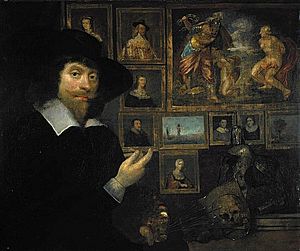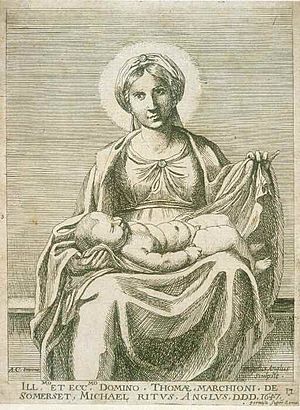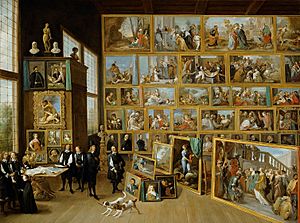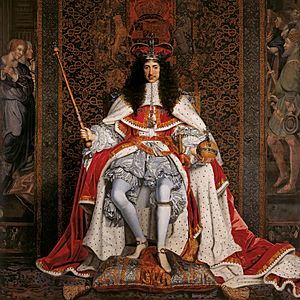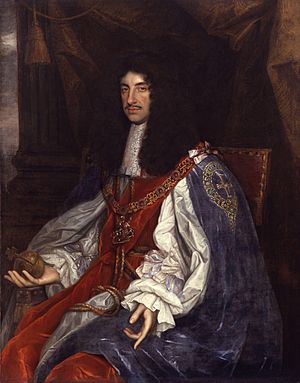John Michael Wright facts for kids
John Michael Wright (born in May 1617, died in July 1694) was a talented portrait painter. He was either English or Scottish, and he painted in the Baroque style. Wright learned his skills in Edinburgh from a painter named George Jamesone. He became very famous as an artist and a scholar during his long stay in Rome, Italy.
In Rome, he joined a special art academy called the Accademia di San Luca. He also worked with many important artists of his time. Later, in 1655, he was hired by Archduke Leopold Wilhelm of Austria to find and buy artworks in England. From 1656, Wright lived permanently in England. He became a court painter for the kings before and after the English Restoration. He was a Roman Catholic and a favorite artist of the Stuart kings, Charles II and James II. He saw many important political events happen during his life. Towards the end of the Stuart monarchy, he went back to Rome as part of a special visit to Pope Innocent XI.
Today, John Michael Wright is seen as one of the best British painters of his time. People especially admire the realistic way he painted portraits. Because he had traveled so much and experienced different cultures, important people in society chose him to paint their pictures. This was unusual because foreign artists were often preferred back then. You can find Wright's paintings of kings, queens, and noble families in many famous art galleries today.
Contents
Who Was John Michael Wright?
John Michael Wright sometimes signed his paintings as "English" and other times as "Scottish." So, we are not completely sure where he was born. A writer named John Evelyn said he was Scottish. But another writer, Thomas Hearne, said Wright was born in London. Records show that a "Mighell Wryghtt" was baptized in London on May 25, 1617. His father, James Wright, was a tailor.
We do know that on April 6, 1636, when Wright was 19, he became an apprentice to George Jamesone. Jamesone was a well-known portrait painter in Edinburgh, Scotland. Records show Wright as "Michaell, son to James W(right), tailor, citizen of London." It's not clear why he moved to Scotland. Maybe his parents had Scottish family connections, or perhaps he moved because of the plague in London.
During his training, Wright probably lived at Jamesone's workshop in Edinburgh. His apprenticeship was supposed to last five years. However, it might have ended early when Jamesone was put in prison in 1639. We don't have any paintings by Wright from this early period. His first known painting is a small portrait from the early 1640s, painted while he was in Rome.
It's also possible that Wright met his wife in Scotland. We don't know much about her. But thirty years later, someone said she was "related to the most noble and distinguished families of Scotland." If this is true, it might explain how Wright later found rich and powerful people to paint. We only know for sure that they had at least one child, a son named Thomas.
Time in Rome and the Netherlands
After his training, Wright might have gone to France. But he definitely ended up in Italy. He might have arrived in Rome as early as 1642. By 1647, he was certainly living there. We don't know many details about his time in Rome. However, his skills and fame grew a lot. By 1648, he became a member of the famous Accademia di San Luca. This academy included many well-known Italian painters. It also had famous foreign artists like Nicolas Poussin from France and Diego Velázquez from Spain. On February 10 of that year, he was also chosen to join the Congregazione dei Virtuosi al Pantheon. This was a group that supported the Roman Catholic faith through art. They held an art show every year in the Pantheon.
Wright stayed in Rome for more than ten years. During this time, he became very good at languages and an expert in art. He also became wealthy enough to collect many books, prints, paintings, jewels, and medals. His collection included works believed to be by famous artists like Mantegna, Michelangelo, Raphael, Titian, and Correggio. He owned about forty paintings, perhaps buying and selling them as well as collecting.
Art Advisor for Archduke Leopold
In 1654, after ten years in Rome, Wright traveled to Brussels. There, Archduke Leopold Wilhelm of Austria noticed his talent. Leopold was the governor of the Spanish Netherlands. He hired Wright not as a painter, but as an advisor on old artworks. The Archduke was very rich and collected many paintings and old objects.
In 1655, the Archduke had good relations with Oliver Cromwell, who was then the leader of England. Leopold had been buying artworks from the English royal family and nobles since King Charles I was executed in 1649. So, he asked Wright to go to London to buy more art. Wright was given a special travel pass to go to England. The pass was dated May 22, 1655. This shows that Wright had left Italy for Flanders by this time. He was called "Juan Miguel Rita, English painter" in the pass. The name "John" was probably added because he had become a Roman Catholic.
As someone on an official mission, Wright would have met the Archduke's ambassadors in London. We don't have many records, so we don't know exactly when he visited or how long he stayed. However, relations between Cromwell and the Archduke's family got worse. So, Wright probably returned to Flanders with any art he bought. He likely arrived just as the Archduke was preparing to leave Brussels in the autumn of 1655.
After his patron moved to Vienna, Wright visited London again. Records don't say much about his work in Flanders. This might be because England and the Archduke's family were now at war. The records also don't mention his membership in the Accademia di San Luca, which would have shown he was Catholic.
Life in England
Wright decided not to go back to Italy. Instead, his family joined him in England soon after. Even though he was Roman Catholic and England was mostly Protestant at the time, Wright found important work. He even painted a portrait of Elizabeth Claypole in 1658. She was Oliver Cromwell's daughter. This painting shows Elizabeth as Minerva, a Roman goddess. She holds a small portrait of her father, Cromwell. This shows Wright was willing to paint for Cromwell, even though he was Catholic. He also painted Colonel John Russell in 1659. Russell was involved in a secret plan to bring King Charles II back to the throne. Some people think this portrait is Wright's best work.
When Charles II became King again in 1660, being Catholic was less of a problem for Wright. The King liked people to have religious freedom. Wright had some money problems, so King Charles let him sell his collection of old master paintings in a lottery. The King himself bought 14 of the paintings. By the early 1660s, Wright had a successful art studio in London. A writer named John Evelyn called him "the famous painter Mr Write."
Later, the Great Plague of London in 1665 forced Wright to move to the countryside. There, he painted at least three members of the Catholic Arundell family. The next year, the Great Fire of London (1666) actually helped him. He received one of the first new art jobs in London. He was asked to paint 22 full-length portraits of the 'Fire Judges'. These judges were appointed to settle property arguments after the fire. These paintings were finished in 1670. They hung in London's Guildhall until it was bombed during World War II. Today, only two of them remain in the Guildhall Art Gallery.
Painting for the King
King Charles II, who supported many Catholics at court, gave Wright some royal art jobs. In 1661, soon after the King's coronation, Wright painted a grand portrait of him. The King is shown sitting in front of a tapestry, wearing his crown and royal robes. Wright was also asked to paint a special ceiling for the King's bedroom at Whitehall Palace. In 1673, he was given the title "picture drawer in ordinary." This allowed him to sign his paintings "Pictor Regis," meaning "Painter to the King."
However, Wright was disappointed because he did not get the most important job, "King's Painter." This job was held by Sir Peter Lely in the 1660s. Lely had a more glamorous style, which the court preferred. Wright's paintings were more realistic and had detailed backgrounds. A writer named Samuel Pepys once said, after visiting both artists, "Lord, the difference that is between their two works."
Wright never received a knighthood like Lely did. But at least one person thought he deserved it. In 1669, Wright met Cosimo III de' Medici, a Grand Duke from Italy. Cosimo later visited Wright's studio and asked him to paint a portrait. In 1673, a woman named Mairie Lady Hermistan wrote to Cosimo. She asked him to talk to the King and ask him to make Wright a baronet (a type of noble title). But nothing came of this request.
As feelings against Catholics grew stronger in London in the late 1670s, Wright spent more time working away from the court. In 1676-77, he painted six family portraits for Sir Walter Bagot in Staffordshire. In 1678, he moved to Dublin, Ireland, for several years. This might have been because of the strong anti-Catholic feelings caused by the "Popish Plot." In Dublin, still calling himself "Pictor Regis," he painted "The Ladies Catherine and Charlotte Talbot." This painting is now in the National Gallery of Ireland. He also painted two full-length portraits of Irish chieftains. These were "Sir Neil O'Neill" (around 1680), now in the Tate Collection, and "Lord Mungo Murray" (around 1683), now in the Scottish National Portrait Gallery. Sir Neil O'Neill was also a Roman Catholic living in Dublin. Wright painted him in the traditional clothes of an Irish chieftain. At his feet is a rare Japanese armor. This armor is thought to be a secret symbol of winning against those who persecuted Catholics. The Japanese were known for this at the time. The portrait of Mungo Murray is special because it is one of the first times Scottish tartan was shown in art.
Trip to Rome with the King
In 1685, when James II, who was openly Roman Catholic, became King, Wright was able to work for the royal family again. However, King James did not hire Wright as an artist. Instead, he gave him a time-consuming job as a steward on a diplomatic trip. Wright was appointed steward to Roger Palmer, the Earl of Castlemaine. Wright's knowledge of Rome and Italian probably helped him get this job. Castlemaine was sent to Pope Innocent XI in 1686. The goal was to show that England could be a Catholic ally in upcoming European conflicts.
Wright's job on this trip was to make sure the fancy coaches, costumes, and decorations for the procession were ready. This procession led to a meeting with the Pope in January 1687. He also organized a huge dinner for a thousand guests in a grand palace. This dinner included sugar sculptures and a large portrait of King James II. While in Rome, Wright published an Italian book about the trip. When he returned, an English version was published in October 1687.
Final Years
Wright's career ended in 1688 when King James II was removed from the throne during the Glorious Revolution. He seemed to accept that his royal favor was over when the Protestant William of Orange became King. Wright lived for six more years in relative poverty until 1694. In March of that year, he made his will. He left his house to his niece, Katherine Vaux. His collection of drawings, prints, and books went to his nephew, Michael Wright, who was also a painter. However, a note in the will said that the books should be sold for his son Thomas, who was abroad. The books were sold on June 4. On August 1, 1694, John Michael Wright was buried.
His Art Legacy
People have only recently started to truly appreciate Wright's artwork. In 1982, an art show called 'John Michael Wright – The King’s Painter' was held in Scotland. This show brought new attention to his work. The book for the show helped uncover many new details about his life. New paintings are still being found and correctly identified as his.
Wright is now considered one of the most successful British artists of the 1600s. He is ranked alongside other painters like Robert Walker and William Dobson. One art show book called him "the finest seventeenth century British-born painter." He was one of the few British artists who painted the most important noble families of his time. He also created some of the most magnificent royal portraits that still exist. This is a big achievement because, back then, British art buyers often preferred foreign artists.
Wright's success is partly due to his unique training. No British artist before him had so much experience with European art. During his time in Italy, he collected works by famous European artists like Michelangelo, Raphael, and Titian. He was also influenced by their style and even copied some of their works.
In his time, Wright was often overshadowed by his rival, Peter Lely, who painted more pictures. One art expert said that comparing them would show Wright's weaknesses. But it would also show his "remarkable independence, his unfailing integrity and charm."
Even if Lely was considered more fashionable, Wright is generally seen as painting more lively and realistic portraits. This supports what Samuel Pepys said: Lely's work was "good but not like" the real person.
See also
In Spanish: John Michael Wright para niños


